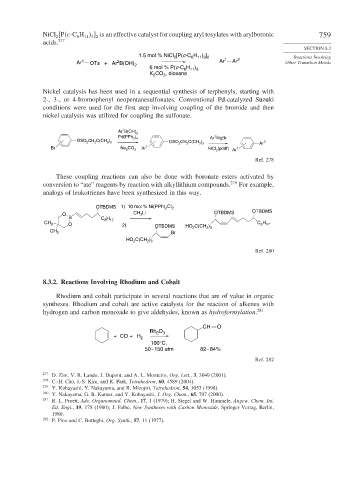Page 783 - Advanced Organic Chemistry Part B - Reactions & Synthesis
P. 783
NiCl P c-C H
is an effective catalyst for coupling aryl tosylates with arylboronic 759
2
11 3 2
6
acids. 277
SECTION 8.3
1.5 mol % NiCl [P(c-C H ) ] Reactions Involving
2
6 11 3 2
2
Ar 1 OTs + Ar B(OH) 2 Ar 1 Ar 2 Other Transition Metals
6 mol % P(c-C H )
6 11 3
K CO , dioxane
2
3
Nickel catalysis has been used in a sequential synthesis of terphenyls, starting with
2-, 3-, or 4-bromophenyl neopentanesulfonates. Conventional Pd-catalyzed Suzuki
conditions were used for the first step involving coupling of the bromide and then
nickel catalysis was utilized for coupling the sulfonate.
1
Ar B(OH)
2
2
Pd(PPh 3 ) 4 Ar MgBr
OSO CH C(CH ) OSO CH C(CH )
2 2 3 3 2 2 3 3 Ar 2
Br Na CO Ar 1 (pddf) 1
2 3 NiCl 2 Ar
Ref. 278
These coupling reactions can also be done with boronate esters activated by
conversion to “ate” reagents by reaction with alkyllithium compounds. 279 For example,
analogs of leukotrienes have been synthesized in this way.
OTBDMS 1) 10 mol % Ni(PPh) 2 Cl 2 OTBDMS
O CH 3 Li OTBDMS
B C 8 H 17
O 2) OTBDMS HO 2 C(CH 2 ) 3
CH 3 C 8 H 17
CH 3 Br
HO 2 C(CH 2 ) 3
Ref. 280
8.3.2. Reactions Involving Rhodium and Cobalt
Rhodium and cobalt participate in several reactions that are of value in organic
syntheses. Rhodium and cobalt are active catalysts for the reaction of alkenes with
hydrogen and carbon monoxide to give aldehydes, known as hydroformylation. 281
CH O
O
Rh 2 3
+ CO + H 2
100°C,
50 –150 atm 82– 84%
Ref. 282
277
D. Zim, V. R. Lando, J. Dupont, and A. L. Monteiro, Org. Lett., 3, 3049 (2001).
278 C.-H. Cho, I.-S. Kim, and K. Park, Tetrahedron, 60, 4589 (2004).
279 Y. Kobayashi, Y. Nakayama, and R. Mizojiri, Tetrahedron, 54, 1053 (1998).
280
Y. Nakayama, G. B. Kumar, and Y. Kobayashi, J. Org. Chem., 65, 707 (2000).
281 R. L. Pruett, Adv. Organometal. Chem., 17, 1 (1979); H. Siegel and W. Himmele, Angew. Chem. Int.
Ed. Engl., 19, 178 (1980); J. Falbe, New Syntheses with Carbon Monoxide, Springer Verlag, Berlin,
1980.
282
P. Pino and C. Botteghi, Org. Synth., 57, 11 (1977).

